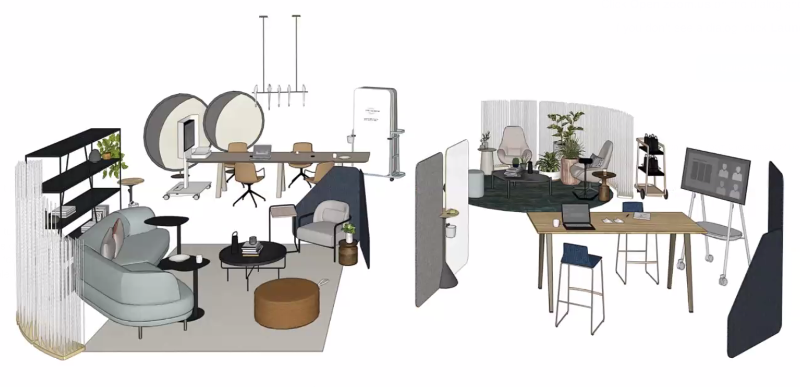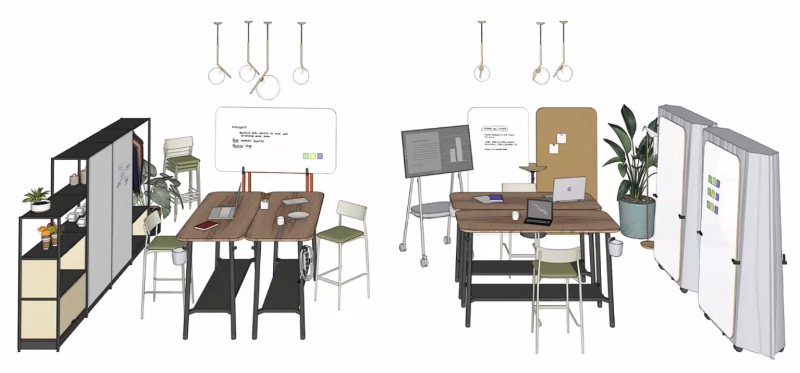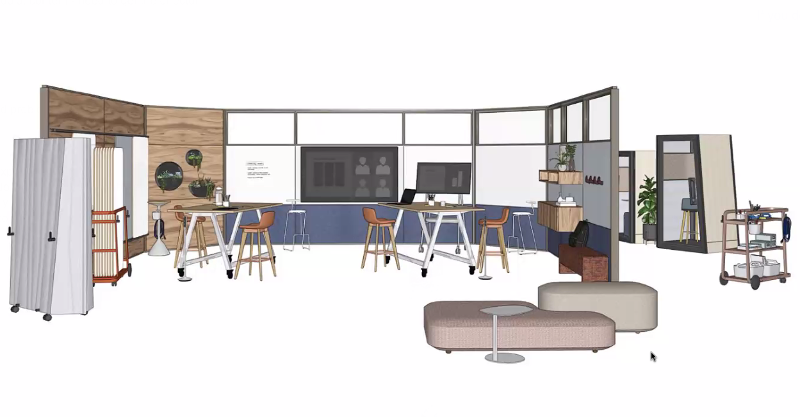A hybrid work model – with some people working in the office and some working at home or in a third place – is expected to become the new normal as organisations adapt to life after Covid. But while the greater flexibility comes with a multitude of benefits for both employees and employers, it won’t come without its challenges.
Last week, Steelcase hosted a live, interactive webinar on all aspects of hybrid work. Chris Congdon, 360 Editor-in-Chief, hosted the webinar and was joined by a panel of experts from across the company. They all shared their insights on the challenges of hybrid work and tips for success.
The challenges of hybrid work
“72% of global organisations are planning some degree of hybrid work. But a hybrid approach is complicated. No one has done this before on this scale.”
A live poll during the webinar revealed people’s biggest worries about hybrid work:
- Maintaining company culture 34%
- Decreasing engagement and productivity 33%
- Harder to innovate and grow 12%
So, what insights did the panel have for making hybrid work a success?
Supporting different modes of work
Collaboration is one of the biggest things that has suffered due to the prolonged period of working from home. There’s been a huge recognition of the importance of getting together in a physical space to collaborate. But organisations need to remember that the workplace isn’t just a space for collaboration. It needs to support all modes of work.
As Rich Benoit, Senior Consultant with the Applied Research + Consulting (ARC) Group at Steelcase, explains:
“The idea that we’re only going to come into the office to collaborate doesn’t really make a lot of sense because that’s not how we schedule our days. The fluidity that all of us go through between individual work, shifting to a sidebar conversation or moving to something more formally scheduled isn’t likely to change.
So organizations need to be much more intentional about supporting how we move from one work mode to another. Just because I come into the office two days a week, doesn’t mean I only need a touchdown space because I’m there “part-time.” I still need access to privacy, the ability to find my colleagues and to be able to work in my rhythm.”
Using furniture products to create boundaries
People want to get back to the office because they miss the energy they get from being around others. But with social distancing likely to remain into 2022, spaces need to be cleverly thought out so that they give people the buzz and connection they are craving, while remaining safe.
Gale Moutrey, Vice President of Workplace Innovation + Brand Management at Steelcase, shared some examples of what these spaces could look like:


Designing spaces for hybrid collaboration
In a hybrid work model, workspaces need to be designed in such a way that they help people in the office and away from the office to work together.
“Figuring out how to braid these digital and physical experiences together is probably the wicked problem of our time. We have to think about this across a variety of collaboration moments between individuals, small and large groups. And we need to design for different types of collaboration as well. Are you sharing information or trying to generate new ideas? We need a greater range of solutions going forward.”
Gale advised that when we think about space, we need to think about three key factors:
- Equity – How do you make it a great experience for people in the room and people who are remote? At the moment, everyone is in equal sized squares on Zoom, but that’s going to change. People in the office will have an advantage over those working remotely. Mobility will be key in solving for this. People in the room should be able to move around, and technology should also be mobile so participants on a screen can be moved around the space.
- Engagement – How do you create spaces that allow people to be as engaged as possible? Tools like virtual whiteboards and places to tack stimuli will help for content to be shared easily and for everyone to get involved.
- Ease – How do you make the space and technology with work with you? People need to be able to enter the session and join easily, using larger technology in the room as well as their own technology - BYOD style.

Supporting technology wellness
Steve Miller, Chief Information Officer at Steelcase, spoke about the challenges of hybrid work when it comes to technology wellness.
“When you think about technology and people’s experiences with it, it’s a little like thinking about wellbeing. We’ve all had that sinking feeling when technology isn’t working as it should. What’s happened during the pandemic is that the equation for wellbeing has changed. When employees spend a lot of time in the office, there are some obvious ways to achieve wellbeing. In a hybrid mode, people are changing what technology they use and where they use it.”
Steve breaks this down into four key areas:
- Care – How can we support employees and their technology needs in hybrid mode?
- Connect – With a greater amount of unassigned spaces in the office, how can we make the journey of coming into the space and connecting and using the technology as easy as possible?
- Control – How can IT manage technology assets when some are sitting in people’s homes?
- Coverage – People are going to be using video tools in more places within the office, how can you ensure network coverage so people can work everywhere possible? Traditionally, rooms would be set up with everything you need for a great video call. But with people doing this all over the space, things like acoustic, barriers, visual backgrounds and moveable lighting will be important.
Success relies on an agile mindset
One of the biggest takeaways from the discussion was that there is no silver bullet for making hybrid work a success. But what is required is an agile mindset. As Steve said right at the end of the webinar,
“We all need to be careful and not do a ribbon cutting on this transformation — nothing will ever be final. We are going to iterate our way through this and learn as we go. There’s not going be a point where we say we’re done. It’s going to be an extended effort.”










